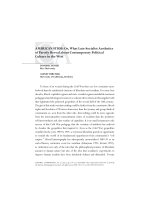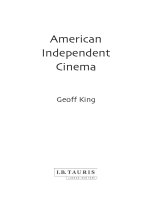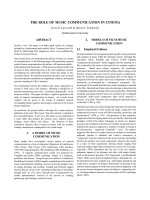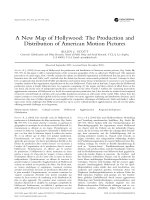American Independent Cinema pot
Bạn đang xem bản rút gọn của tài liệu. Xem và tải ngay bản đầy đủ của tài liệu tại đây (150.5 KB, 26 trang )
American
Independent
Cinema
Geoff KingList of Illustrations vii
Acknowledgements ix
Introduction: How Independent? 1
1. Industry 11
2. Narrative 59
3. Form 105
4. Genre 165
5. Alternative Visions: Social, Political and Ideological
Dimensions of Independent Cinema 197
Coda: Merging with the Mainstream, or Staying Indie? 261
Notes 265
Select Bibliography 277
Index 283
Contents
Illustrations
1. Stranger Than Paradise 3
2. The Blair Witch Project 15
3. sex, lies, and videotape 35
4. Gummo 64
5. Mystery Train 94
6. Laws of Gravity 116
7. Safe 126
8. Elephant 148
9. Kill Bill Vol. 1 159
10. Martin 169
11. Reservoir Dogs 184
12. She’s Gotta Have It 212
13. Straight Out of Brooklyn 218
14. Swoon 228
15. The Doom Generation 236
Introduction
How Independent?
From the lowest-budget, most formally audacious or politically radical
to the quirky, the offbeat, the cultish and the more conventional, the
independent sector has thrived in American cinema in the past two
decades, producing a body of work that stands out from the dominant
Hollywood mainstream and that includes many of the most distinctive
films to have appeared in the USA in recent years. It represents a
challenge to Hollywood, although also one that has been embraced
by the commercial mainstream to a substantial extent. Major formerly
independent distributors such as Miramax and New Line are attached
to Hollywood studios (Disney and Time-Warner, respectively), while
some prominent directors from the independent sector have been
signed up for Hollywood duty. The ‘independence’ of American
independent cinema, or exactly what kind of production qualifies
for the term, is constantly under question, on a variety of grounds.
At the same time, the independent sector continues to thrive and to
maintain an identity that is distinctive, even if not entirely separable
from Hollywood.
Exactly how ‘independence’ is defined can vary in both form
and degree. This book is organized around three main points of
AMERICAN INDEPENDENT CINEMA
2
orientation: the position of individual films, or filmmakers, in terms of
(1) their industrial location, (2) the kinds of formal/aesthetic strategies
they adopt and (3) their relationship to the broader social, cultural,
political or ideological landscape. Strategies vary, at each level. Some
films customarily designated as ‘independent’ operate at a distance
from the mainstream in all three respects: they are produced in an
ultra-low-budget world a million miles from that of the Hollywood
blockbuster; they adopt formal strategies that disrupt or abandon
the smoothly flowing conventions associated with the mainstream
Hollywood style; and they offer challenging perspectives on social
issues, a rarity in Hollywood. Others exist in a closer, sometimes
symbiotic relationship with the Hollywood behemoth, offering a
distinctive touch within more conventional frameworks. In between
are many shades of difference.
A degree of distance, industrially, from the Hollywood studio system
often appears to be a necessary condition for substantial formal or
socio-political departure from the dominant norms. Lower budgets
and less marketing-driven filmmaking generally permit greater licence.
But this can be relative. How, exactly, any individual title is marked
as sufficiently different from the Hollywood mainstream to qualify as
independent is subject to numerous variations explored in detail in
this book. Some lean towards an ‘artistic’ form and content, merging at
one end with works usually defined as ‘experimental’ or ‘avant-garde’.
Others are more avowedly ‘political’ or polemical in intent. The ‘artistic’
and the ‘political’ are far from separate categories, however. Formal
experiment and departure from dominant conventions is, potentially, a
major resource for the deconstruction of dominant ideologies. Other
examples of American independent cinema are less lofty in their
ambitions, taking up the inheritance of lower-budget ‘exploitation’
cinema, for example, or seeking to carve a niche through the creation
of ‘quality’, stylish, cultish or offbeat films, the primary goal of which
remains the provision of profit-generating entertainment.
One of the main aims of this book is to chart the contours of
American independent cinema within these coordinates. Independent
cinema exists in the overlapping territory between Hollywood and
a number of alternatives: the experimental ‘avant-garde’, the more
accessible ‘art’ or ‘quality’ cinema, the politically engaged, the low-
3
INTRODUCTION
budget exploitation film and the more generally offbeat or eccentric.
The principal focus of American Independent Cinema is on the particular
versions of independent cinema that came to prominence from the
mid 1980s with the appearance of milestone films such as Stranger Than
Paradise (Jim Jarmusch, 1984), sex, lies, and videotape (Steven Soderbergh,
1989) and
Clerks (Kevin Smith, 1994). The terms ‘independent’ or
‘indie’ – the latter often used to distinguish this particular version of
independence – are used primarily in the sense in which they became
established in the wider culture in this period, rather than according
to a fixed or more literal definition. To understand the forces shaping
this particular notion of independence, however, a number of different
historical roots and predecessors have also to be considered.
Taken literally, the ‘independent’ sector has a much longer and
broader history than that which forms the main subject of this book.
At its earliest, the term was used to describe producers operating
in the shadow of the three companies – Edison, Biograph and
Vitagraph – that dominated the film business in the 1890s and 1900s.
Early independents faced a constant threat of legal action, control
1. Not much doing really – but a milestone in the developing indie
scene of the 1980s: Stranger Than Paradise (1984).
AMERICAN INDEPENDENT CINEMA
4
over the industry in this period being exerted partly through the
ownership of patents that sought to restrict access to key aspects of
film technology. From this early stage, the term ‘independent’ gained
romantic connotation, signifying the brave efforts of rebels fighting
against a powerful trust. Independent production in this era is often
given the credit for a number of landmark developments, including
the shift of the centre of gravity of the film business to California and
the initiation of the star system, although both claims owe more to
myth than reality.
1
The independents formed their own alliance in
opposition to the patents company and, Janet Staiger suggests, used a
number of similar strategies; the result was the division of the industry
into two rival blocs.
2
The patents company was declared to be an illegal restraint
of trade and dissolved in 1915. It was soon replaced, however, by
what was to become the Hollywood studio system, a vertically
integrated operation in which the five major studios dominated
the production, distribution and exhibition of features in the USA
and much of the rest of the world. The studio system underwent
substantial reorientation from the 1950s, in the face of further federal
regulation and broader social change, but its dominance has remained
largely in place. In the context of an industrial regime dominated by
Hollywood, independent activity has tended to fall into one of two
general categories: either inside or outside the orbit of the majors.
Within the gravitational pull of the studios, independent production
has been found at both the upper and lower ends of the business.
Low-budget independent outfits such as Republic and Monogram,
and many smaller entities, helped to serve the demand of the system
for the production of ‘B’ movies, to fill the bottom half of double
bills, during the 1930s.
3
At the same time, independent producers
such as David Selznick and Sam Goldwyn produced expensive ‘A’
features, borrowing stars and leasing studio space from the majors and
supplying prestige films such as Gone with the Wind (1939) and
Rebecca
(1940) that profited the studios by playing in their important first-run
theatres. The most high-profile A-list move into independence from
the studios was launched earlier, in 1919, with the founding of United
Artists, a distribution company created to handle the films of Mary
Pickford, Charles Chaplin, Douglas Fairbanks and D.W. Griffith.
5
INTRODUCTION
The success of Selznick, in particular, as an independent producer
working closely with the studios, pointed the way towards what was
to be the future structure of Hollywood production, which became
increasingly organized on a contracted-out basis from the 1950s
onwards. The studio production-line system gave way to the package
system, in which individual film projects were put together on a one-
off basis. A great deal of Hollywood production today can be described
as ‘independent’ in this sense, in that projects are often initiated and
pursued by entities that exist formally beyond the bounds of the
majors. These include production companies set up by producers,
directors and stars, often working closely with one studio or another,
and some larger independent companies. In most such cases the films
that result belong solidly to the Hollywood mainstream. Hollywood
remains the principal source of funding and distribution, even when
only a relatively small proportion of production is conducted entirely
in-house. Technically independent productions include Hollywood
blockbusters such as Terminator 2: Judgment Day (1991) and
Basic
Instinct (1992), produced by the independent Carolco in an alliance
with TriStar Pictures. As with the likes of Selznick, arrangements with
independents such as Carolco, Castle Rock and Morgan’s Creek in
the 1990s gave the studios extra flexibility, to work in partnerships
that reduced their risks, especially at the higher-budget end of the
spectrum.
4
It is clear that formal independence of this variety in the
industrial domain is, in itself, no guarantee of independent qualities
of other kinds.
If some forms of independent production have worked closely
in unison with Hollywood, others have operated in areas in which
Hollywood has chosen not to tread, sometimes teaching valuable lessons
to the dominant institution. Necessity has often driven independent
operators to be the pioneers of American cinema, exploring new
avenues in their search for territories not already colonized by the
major studios. The early independents took cinema to parts of rural
America, including the gold camps of Alaska, that were not served by
the big companies.
5
Technological innovations have also come from
independent sources in some cases: the development of widescreen
processes and 3D in the 1950s, for example, originated outside the
control of the studios. Both historically and today, independent
AMERICAN INDEPENDENT CINEMA
6
producers have often served specialized, niche audiences of one kind
or another. A good example during the classical Hollywood studio
era is low-budget independent black-oriented filmmaking, which,
although often white owned and financed, catered specifically for
black audiences from the silent era until the Second World War.
The most significant audience for which Hollywood failed to
cater in the immediate post-war decades, and which created the basis
for some of the most important strains of independent production,
was the youth audience. Hollywood was very slow to respond to
demographic and other social changes during the 1950s and 1960s
that created a large audience receptive to material targeted at teenage
viewers. Into the gap stepped a number of independent producers, the
best known being American Independent Pictures (AIP), supplying
the teen audience with a range of low-budget horror, hot-rod, biker
and beach-blanket movies. Such films tended to be in ‘disreputable’
genres unfavoured by Hollywood. They were sold using ‘exploitation’
tactics, sensational titles and posters giving the impression of more
lurid thrills than were usually delivered by the low-production-value
material actually presented on-screen.
If this was a version of independence that was nakedly commercial
in intent, the independent scene of the later 1950s and 1960s
also saw a flowering of more ‘artistic’ and in some cases ‘avant-
garde’ independent filmmaking. The birth of something akin to an
‘American New Wave’, to match those of contemporary European
cinema, was announced in the early 1960s. The more narrative- and
character-led manifestations of this development – films such as John
Cassavetes’
Shadows (1960) – can be seen as direct predecessors of
the indie scene of the 1980s and 1990s. Examples from the avant-
garde end of the spectrum, in some cases dating back to the 1940s,
include formalist experimentation by filmmakers such as Maya Deren
and Stan Brakhage and the ‘underground’ films of Andy Warhol. The
avant-garde remained largely isolated, as in almost all cases a strictly
non-commercial and rigorously independent undertaking. The
strands of ‘exploitation’, ‘art’ and ‘underground’ cinema sometimes
came closer together, however, jointly forming important sources for
the Hollywood ‘Renaissance’ of the late 1960s to the mid to late
1970s, a period in which a financially struggling Hollywood finally
7
INTRODUCTION
began to come to terms with its changed demographic and social
context. The commercial success of independent youth-oriented
pictures such as those of AIP was matched by that of some more edgy
and disturbing independent productions in the same generic territory,
especially horror. Films such as Night of the Living Dead (1968) and
The Texas Chain Saw Massacre (1974) proved highly successful at the
box office, pushing back the boundaries of conventional exploitation-
horror material and combining this with a more negative portrait
of American society that resonated with contemporary angst and
unrest in the era of events such as racial uprising, the Vietnam war
and Watergate.
The response of Hollywood was to embrace some of this material. A
landmark move was the decision by Columbia to distribute Easy Rider
(1969), a project originally destined to become another biker picture
for AIP. The success of Easy Rider helped convince the studios to invest
in a new generation of filmmakers seen to be more in touch with
the youth audience affected by the 1960s counterculture. Hollywood
learned other lessons from the independents in this period. Along
with a number of foreign imports, independent features demonstrated
the box-office appeal of more racy, controversial or ‘adult’ material,
encouraging the adoption by Hollywood of the ratings system, which
widened the bounds of what could be offered to audiences from 1968.
Examples ranged from gory low-budget horror to the sexploitation
films of Russ Meyer. Elements of independent ‘exploitation’ strategy
were also embraced by Hollywood in its more mainstream, blockbuster
productions, especially the strategy of combining wide opening release
patterns with saturation advertising, in order to recoup costs quickly.
A number of Hollywood’s biggest-grossing films of the 1970s were, in
part, bigger-budget and glossier versions of independent exploitation
fare, especially
The Exorcist (1973) and Jaws (1975).
Hollywood stole some of the ground of the independents during
the 1970s, encouraging some independents into more extreme or
‘outrageous’ ground to maintain their marketable differences: the raw
horror of The Texas Chain Saw Massacre, the harder-core sexploitation
of Deep Throat (1972), the cult ‘bad taste’ trash extremes of John Waters’
Pink Flamingos (1973). Independent operation remained the main
source of development in the slasher and splatter varieties of horror, but
AMERICAN INDEPENDENT CINEMA
8
this was another terrain onto which Hollywood was quick to move in
the light of the box-office success of
Halloween (1978) and Friday the
13th (1980). If the more commercial/exploitation end of independent
cinema was to a large extent taken over by larger-budget Hollywood
productions, the same was only partially and briefly true of the ‘art’
film component. The Hollywood Renaissance embraced aspects of
‘art’ cinema to some extent, but it proved short-lived, the product of
a period of transition that soon passed in the later 1970s, with both
the consolidation of a blockbuster-centred regime in Hollywood and
a political turn to the right in American culture. Space for edgier,
more questioning or ‘difficult’ filmmaking was generally reduced in
Hollywood from the end of the decade. Some individuals associated
with the Hollywood Renaissance continued to make less conventional
films, sometimes for the studios, where past box-office achievements
or status and reputation gave them sufficient clout (Martin Scorsese,
for example), sometimes in the independent realm or with funding
from television (as in the case of Robert Altman during the 1980s).
Hollywood’s loss, in terms of the general narrowing of the horizons
of possibility at the heart of the studio-led machine, was to be the
gain of a newly consolidating form of independent production and
distribution that was beginning to take shape during the 1980s, and
into which some of the inheritance of the Renaissance was carried.
The term ‘independent’ has had rather different connotations at
different periods in the history of American cinema. In the 1930s,
for example, it signified ‘something less than trash’.
6
In the late 1950s
and early 1960s it might have suggested both the innovations of
the ‘American New Wave’ and the low-budget exploitation science
fiction and horror made by Roger Corman for AIP. The ‘New
Wave’ proved fragmentary and short-lived, breaking down during
the 1960s into its separate art/personal/expressive feature film and
more underground/experimental short components. Accessible non-
Hollywood features were still produced, but, as Geoff Andrew suggests,
‘they were so infrequent, and usually achieved such a low audience
profile, that there was little sense of continuity, let alone of any kind of
“movement”.’
7
From the mid 1980s, however, the more arty/quirky,
sometimes politically inflected, brand of independent cinema began to
gain a higher profile and a more sustained and institutionalized base in
9
INTRODUCTION
the broadly off-Hollywood arena. Explanations for this development
will be suggested in greater detail in Chapter 1, which focuses on
the industrial dimension of recent and contemporary American
independent cinema, but the generally inhospitable climate of the
Hollywood mainstream during the 1980s and into the 1990s was
certainly a factor.
The industrial realm is, clearly, an important part of any definition
of independent cinema. In Greg Merritt’s account, Celluloid Mavericks:
A History of American Independent Film, it is the single, defining
characteristic. An independent film, for Merritt, is ‘any motion
picture financed and produced completely autonomous of
all studios,
regardless of size’.
8
Films made by smaller studios or given a guarantee
of distribution by one of the majors before production are classified as
‘semi-indie’. In neither case, in Merritt’s account, is style or content a
consideration. Any other basis of definition is ‘too slippery’, including
‘the widely held belief that independence is determined not by
financing but by “spirit”, by professing an alternative vision’.
9
My
argument, however, is that independent cinema is not best defined in
such narrow and literal terms. Industrial factors are important, but do
not provide the only grounds for definition of the particular varieties
of filmmaking to which the label independent has most prominently
been attached in recent decades. Other definitions may be somewhat
slippery, but the feature-length, narrative-based independent cinema
examined in this book is not a single, unified entity. ‘Independence’ is
a relative rather than an absolute quality and can be defined as such at
the industrial and other levels. It is this dynamic quality, drawing on a
range of traditions, that makes it such a rich, variable and fascinating
part of the cinematic landscape.
American Independent Cinema starts with consideration of the
industrial context because it is in this dimension that many of the
conditions of existence of independent cinema are set. The gradual
establishment of an industrial infrastructure, particularly in distribution,
was a key factor in the emergence of the type of indie scene that
came to fruition in the 1980s and 1990s. In general – but with some
exceptions – the term ‘independent’ as used in this book requires an
industrial location that is either clearly independent or somewhere
in the grey area often known as ‘Indiewood’, which includes studio-
AMERICAN INDEPENDENT CINEMA
10
owned/affiliated ‘specialist’ or ‘independent’ labels. But it would be
an impoverished definition of independent cinema that ignored the
qualities of the films themselves. If indie films are often described by
the use of somewhat vague terms such as ‘quirky’ and ‘offbeat’, one
of the aims of this book is to examine some of the particular devices
that create such qualities, to seek a grasp on the slippery notion of
‘alternative vision’ at the levels of both form (principally in Chapters
2 to 4) and content (principally in Chapter 5). Where departures from
mainstream convention are found at the formal level, they tend to be in
two main directions: either in making greater claims to verisimilitude/
realism, or in the use of more complex, stylized, expressive, showy
or self-conscious forms. In content, many independent films offer
visions of society not usually found in the mainstream, although the
bounds of difference are often limited. The characteristic location of
that which is designated by the terms ‘indie’ or ‘independent’, in the
dominant senses in which they are used here, is a space that exists
between the more familiar-conventional mainstream and the more
radical departures of the avant-garde or the underground.
Unlike many accounts of American independent cinema, this
book does not take the individual filmmaker as a major point of
organization (there are no chapters devoted specifically to figures
such as Jim Jarmusch, John Sayles, Hal Hartley, Todd Haynes or
Quentin Tarantino). The indie sector is, clearly, a place where more
scope generally exists than in Hollywood for the pursuit of auteurist
individual freedom of expression; for filmmakers to express their
own particular visions of the world through choices of form and
content.
10
What this book seeks to identify, however, is the existence
of a number of different (overlapping) modes of independent practice,
institutionalized or partially institutionalized forms that include but
also go beyond the particular concerns of the many individuals whose
work has contributed to the vibrancy of independent alternatives to
the Hollywood mainstream.
Index
About Schmidt, 259–260
Acapulco Black Film Festival, 220
Adaptation, 98–99
Addiction, The, 174, 191
advertising, 15, 29
African American Filmmakers
Association, 219
Ahearn, Charles, 31–2
Akerman, Chantal, 70, 147
All the Vermeers in New York, 141, 145
Alma’s Rainbow, 223
Almereyda, Michael, 12, 136–137,
165
Alpine Pictures, 193
Altman, Robert, 8, 34, 49, 86
alt.sex, 54
American Beauty, 47
American Independent Pictures
(AIP), 6, 7, 8
American New Wave, 6, 8, 21
American Playhouse, 20
Anders, Allison, 80, 225–226
Anderson, Paul Thomas, 77, 86, 127,
262
Anderson, Wes, 31, 81, 135, 262
Andrew, Geoff, 8
Anger, Kenneth, 228
Another Girl Another Planet, 12,
136–137
Antonioni, Michelangelo, 16, 210
Araki, Greg, 13, 51, 83, 227,
232–237, 248, 249
Aronofsky, Darren, 48, 49, 128
Arroyo, José, 233, 235
art cinema, 2, 6, 17, 26, 32, 51, 70,
102, 139
Artisan Entertainment, 15, 48–9, 50
Ashes and Embers, 205–206, 207, 209
Asian American production, 220,
221–222
At Land, 174
Atlantic Releasing, 26
AMERICAN INDEPENDENT CINEMA
284
AtomFilms, 54
audiences, 23, 29–30, 149–150,
197–200, 259
Austin Powers: The Spy Who Shagged
Me, 33
avant-garde films/filmmaking, 1, 6,
10, 11, 13, 16–17, 68–70, 106,
130, 137–138, 192, 228, 247
Back and Forth, 138, 145
Ballad of Gregorio Cortez, The, 24,
29–30, 181
Bamboozled, 211, 216
Basic Instinct, 5
Bauer International, 17
Bed You Sleep In, The, 139–140, 145
Being John Malkovich, 98, 249
Benning, Sadie, 242
Bergman, Ingmar, 16
Bernard, Tom, 162
Berney, Bob, 39
Bertolucci, Bernardo, 17
Bickernicks, Eric, 54
Big Sleep, The, 194
Big Lebowski, The, 83, 194
Big One, The, 257–258
Birth of a Nation, The, 202
Biskind, Peter, 45
Black Cinema Café, 220
Black Filmmaker Foundation, 219
black or black-oriented films/
filmmaking, 6, 185, 199, 200,
201–220, 222–223, 241–242,
249
Blair Witch Project, The, 12, 14, 15,
27, 28, 29, 31, 39, 48, 50,
112–113, 114–115, 116, 117,
118, 163, 166, 167, 192–193
blaxploitation, 201–202
Bless Their Little Hearts, 203, 205,
208–209
Blood for Dracula, 191, 192
Blood Simple, 151, 152, 153, 194
Bob Roberts, 254
Book of Life, The, 120–121
Borden, Lizzie, 224–225
Bordwell, David, 60–61, 62, 82,
101–102, 146
Born in Flames, 224–225
Bottle Rocket, 81, 135–136
Bound, 152
Bowling for Columbine, 257, 258
Boys Don’t Cry, 244–246
Boyz ‘N’ the Hood, 217
Boxes, 12
Brakhage, Stan, 6, 69–70
Brecht, Bertolt, 253–254
Brother From Another Planet, The, 253
Brothers Grimm, The, 45
Buena Vista Social Club, The, 49
Buffalo 66, 124, 131–132, 155, 157
Burnett, Charles, 201, 203–205,
209–211
Bush Mama, 205, 209, 212
Cajayon, Gene, 39
Cannes Film Festival, 27, 33, 34, 43
Capra, Frank, 194
Carney, Ray, 112
Carolco, 5
Cassavetes, John, 6, 12, 18, 71, 74,
75, 76, 84, 108, 112, 121–122,
157, 176–180
Castle Hill, 20
Castle Rock, 5
Cat People, 174
285
INDEX
Center of the World, The, 111
Chan is Missing, 21, 221
Chicano/Latino production,
220–221
Chinese American production,
221–222
Chocolate City, 220
Cholodenko, Lisa, 242
Chuck and Buck, 111, 120, 243, 249
Cinecom, 20, 25
Cinema 16, 16, 17
Cinema V, 17, 32
CinemaNow, 54–5
Circle Releasing, 25, 159
Citizen Ruth, 259
City of Hope, 252–253
Clarke, Shirley, 17
Clark, Larry, 42, 118
Clerks, 3, 13, 14, 15, 21, 81–2, 83,
85, 194, 195
Clockers, 211
Cohen, Joel and Ethan, 25, 83, 107,
151–152, 157–158, 159, 194
Collins, Kathleen, 223
Columbia Pictures, 7, 29, 41, 211, 217
comedy, 183–189, 198, 216, 226
Conrad, Tony, 138
Convent, The, 193
Cool World, The, 17
Corman, Roger, 8
Corporation for Public Broadcasting,
29
Crash, 43
Creative Film Foundation, 16
Crimewave, 158
Cronenberg, David, 43
Crooklyn, 211
Cruise, The, 52
Cruz Brothers and Miss Malloy,
The,
223
Crying Game, The, 32, 47
Cuban, Mark, and Todd Wagner,
50, 55
cultural capital, 157, 240
Dash, Julie, 46, 201, 207, 209–211
Daughters of the Dust, 46, 207–208,
209, 222, 223
Davis, Glyn, 236–237
Daytrippers, The, 81
Dead Man, 103
Debut, The, 39–40
Deep Throat, 7
De Antonio, Emile, 255, 256
De Laurentis Entertainment Group,
26
Deren, Maya, 6, 16, 174
Desert Hearts, 229
Desperately Seeking Susan, 225–226
Deutchman, Ira, 25, 55
digital video (DV), 11, 12, 14, 51–4,
111–112, 119–121, 258
Dimension Films, 44, 45, 166
Dim Sum: A Little Bit of Heart, 222
Dirty Dancing, 25
Disney, 1, 26, 41, 42–3, 159
distribution, 13, 14–16, 17–19,
26–40, 41–51, 53–56
documentary, 52, 69, 108, 109, 203,
225, 241, 254, 255–258
Dogma, 43
Dogme 95, 52
Doom Generation, The, 232, 233,
235–236, 248
Do the Right Thing, 154, 211, 213,
215
AMERICAN INDEPENDENT CINEMA
286
Doty, Alexander, 242–243
Down by Law, 72–3, 76
Dreamworks, SKG, 41, 47
Dr. T and the Women, 49
Dumb and Dumber, 33
Dunye, Cheryl, 241–242
DVD, 24, 55
Dyer, Richard, 240–241, 242, 244
Easy Rider, 7
Eat, Drink, Man, Woman, 222
Eating Raoul, 21
Edward II, 235
Elephant, 147–148
El Mariarchi, 12, 13, 14, 158, 160
El Norte, 21, 220
Embassy Pictures, 29–30
Emerging Pictures and Emerging
Cinemas, 55
Emma, 36
Empire, 69
Engel, Morris and Ruth Orkin,
109–9
Eraserhead, 99, 133
Erin Brokovich, 262
Evil Dead, The, 150–151, 152–153,
155–156, 158, 165, 192, 193
Evil Dead II, 150, 153, 158
exhibition, 13, 16–17, 24, 36, 50,
55, 220
Exorcist, The, 7
exploitation cinema, 2, 6, 7, 8, 27,
30, 166, 174, 200
Faces, 122
Faces Films, 18
Fahrenheit 911, 43, 258
Far from Heaven, 242
Fargo, 194
Fellowship Adventure Group, 43
Ferrara, Abel, 174
Fessenden, Larry, 55, 165, 170,
174–176
Festen/Celebration, 52
festivals, general, 19–20, 38, 53
Figgis, Mike, 112
Fight Club, 162
FilmDallas, 26
Filmmaker, 56
Filmmaker’s Cooperative, 16
Film Movement, The, 55
finance, 12–16, 23–24, 25, 37
Fincher, David, 162
Finding Forrester, 160
Fine Line Features, 25, 33, 34, 44
Fireworks Pictures, 50
First Look Pictures, 50
First Run Features, 20, 31
Flesh for Frankenstein, 191, 192
Flicker, The, 138
Flirt, 93, 95–6, 97
Focus Features, 41, 42
formal dimensions of independent
cinema, 2, 10, 106–164
claims to the status of
verisimilitude, 10, 107–119,
120–123, 162, 167, 175, 176,
177, 181, 202, 203–204
expressive or stylized forms,
10, 119–137, 162, 167–8, 175,
176, 202, 206
foregrounded form (see also
artistic/stylized motivation),
137–159, 162
Fox Searchlight, 41
Frameup, 140, 141, 145, 155, 190–191
287
INDEX
Friday the 13th, 8
Frisk, 231–232, 233, 237, 244
Full Frontal, 262
Gabriel, Teshome H., 207, 208
Gallo, Vincent, 131
Gangs of New York, 45
gangster/crime films, 176–181,
182–183
Gas, Food, Lodging, 80, 226
gender, 222–249
genre, 165–195
Gerima, Haile, 201, 204–207
Gerry, 146–147, 160
Get on the Bus, 211, 213
Ghost Dog: Way of the Samurai, 180–181
Gift, The, 158
Gilliam, Terry, 45
Gilmore, Geoff, 35, 51
Girlfriends, 224
Girl 6, 125, 211
Glass Shield, The, 211
Godard, Jean-Luc, 17, 19, 83, 234,
236, 254
Gods and Monsters, 244–245
Godzilla, 159
Go Fish, 14, 21, 242, 246–247
Go Fish (company), 41
Goldwyn, Sam, 4
Gombrich, E.H., 157
Gomez, Nick, 12, 79
Gone with the Wind, 4
Good Girl, The, 80
Good Machine, 14, 36, 41, 43, 226
Good Will Hunting, 44, 160
Gramercy Pictures, 249
Gray’s Anatomy, 262
Groove, 76–7
Guerrero, Ed, 216
Gummo, 63–68, 74, 85, 110–111,
159–160
Habit, 165, 167, 170–174, 175, 176,
191, 193
Halloween, 8
Halloween H20, 44
Hammer, Barbara, 242
Happiness, 14, 43, 86, 88, 90, 91,
197–199, 200, 239, 259
Hard Eight, 77–8, 81
Hardy, Robert, 220
Harlan County, USA, 251, 255
Harrington, Curtis, 168, 174
Harris, Julie, 223
Harrison, Greg, 76–7
Hartley, Hal, 10, 83, 93, 120, 187
Hav Plenty, 219
Haynes, Todd, 10, 92, 125, 227, 238,
242
Heartland, 24, 181–182
Hennessy, Rosemary, 240, 243
Henry: Portrait of a Serial Killer, 73–4,
105–6, 107, 117–118, 167
High Art, 242
Hitchcock, Alfred, 127, 231
Hollywood Renaissance, 6–7, 8
Hollywood Shuffle, 12, 13, 30,
184–185, 215–216
Hollywood studios/studio system,
4, 18, 41–44
Holofcener, Nicole, 226
Hoop Dreams, 256
Hooper, Tobe, 167
Hope, Ted, 36
horror, 6, 7–8, 44, 165, 166, 167–
176, 191–193
AMERICAN INDEPENDENT CINEMA
288
House on 92nd Street, The, 109
Hudsucker Proxy, The, 194
Hughes, Allen and Albert, 217
I Am Curious (Yellow), 32
IFC Films, 39, 40, 43, 50
IFC Productions, 40
IFILM, 54
Incredibly True Adventures of Two Girls
in Love, 242, 247–248
Independent Digital Entertainment
(InDigEnt), 52–3, 111
Independent Distribution Partners,
50
Independent Feature Film Market,
20, 38, 51
Independent Feature Project, 20, 29
Independent Film Channel, 12, 21,
40, 52
Independent Spirit Awards, 56
indieWIRE, 56
Indiewood, 9, 45, 249, 262, 263
industrial dimensions of
independent cinema, 2, 9,
11–57
internet, marketing/distribution,
28, 54
In the Bedroom, 44, 163
In the Year of the Pig, 255, 256
Island/Alive, 20, 26
Italian Neorealism, 70, 203, 204
Jancsó, Miklos, 210
James, David, 71
Jarman, Derek, 230, 235
Jarmusch, Jim, 3, 10, 71–3, 76, 82,
93, 103, 146, 180–181, 261
Jaws, 7, 127
Jeanne Dielman, 23 Quai du commerce,
70
Jeffrey, 247
Jonze, Spike, 262
Jost, Jon, 139–142, 144–146, 155,
190
Julien Donkey-Boy, 65–68, 76, 110–
111, 119–120, 120, 123–124,
125, 130–131, 139, 161
Julien, Isaac, 230
Jungle Fever, 125, 211, 212–213
Just Another Girl on the IRT, 223
Kafka, 262
Kalin, Tom, 160, 227
Kaplan, Caroline, 52
Kaufman, Charles, 98
Kids, 42–3, 118–119, 159
Kill Bill Vol. 1, 158, 159
Killer of Sheep, 203–205, 206,
208–209, 212
Killing of a Chinese Bookie, The,
176–180
King of the Hill, 262
Kleinhans, Chuck, 46
Kopple, Barbara, 251, 255
Korine, Harmony, 59, 63–68, 74, 76,
83, 109–110, 118, 159–160,
263
Labor Film Service, 250
Ladri di Biciclette
/Bicycle Thieves, 204
Landmark Theaters, 50, 55
LA School, 201, 203–211, 216, 240,
250
Laws of Gravity, 12, 14, 79, 116–117,
118, 119, 195, 242
Leacock, Richard, 109, 255
289
INDEX
Lee, Ang, 222
Lee, Spike, 12, 125, 154, 201, 203,
211–215, 240
left-of-centre filmmaking, 249–258
Levy, Emanuel, 216
L.I.E., 156
Life Is Beautiful, 44
Limey, The, 49, 142–144, 146, 149,
165, 193, 262
Linklater, Richard, 53, 84, 111, 120
Lion’s Gate Entertainment, 43,
48–9, 53, 54
Liquid Sky, 21
Little Fugitive, 108–9
Little Shots of Happiness, 121
Living End, The, 13, 51, 227, 232–
233, 234–235, 236, 242
Living on Tokyo Time, 73
Livingston, Jennie, 241
Lonesome Cowboys, 189–190, 191
Longtime Companion, 229–230
Lord of the Rings, 33, 47
Losing Ground, 223
Lost Highway, 99–100, 132–133,
135, 193
Love Jones, 219
Lovely and Amazing, 226–227
Lovers and Lollipops, 108
Love Your Mama, 223
Lukács, Georg, 253
Lynch, David, 99–101, 132–134
Madstone Films, 49–50
Magdalene Sisters, The, 43
Maggenti, Maria, 242
Magnolia, 34, 86, 88–90, 91–2. 98
Magnolia Pictures, 50
Malcom X, 211, 215
Malin, Amir, 36
Man Who Wasn’t There, The, 158
Margulies, Ivone, 121
marketing, 13, 15–16, 26–40,
191–192, 219, 240
Martin, 168–170, 172, 173, 191
Masculin-Féminin, 83
Masilela, Ntongela, 210
Mask, The, 33
Matewan, 25, 251–252
Maysles, Albert and David, 109
McGuire, Anne, 104
Meistrich, Larry, 55
Mekas, Jonas, 16
melodrama, 69, 182, 195, 204, 206,
221, 239, 259
Memento, 38–9, 99, 102, 104, 193
Menace II Society, 217
Merritt, Greg, 9, 18
Meyer, Russ, 7
MGM/UA, 41
microbudget production, 12–13
micro-indie distributors, 49–51
Miller, Bennett, 52
Miller, Rebecca, 52
Millhouse: A White Comedy, 255, 256
Miramax, 1, 15, 17, 19, 21, 26, 32–3,
34, 36, 41–5, 53, 159, 166, 200,
211
Mi Vida Loca, 226
Mo’ Better Blues, 211
modality, 183–184
Moore, Michael, 43, 256–258
Morgan’s Creek, 5
Morrissey, Paul, 69, 189–190, 191,
192, 236
motivation
compositional, 67, 83
AMERICAN INDEPENDENT CINEMA
290
realistic/verisimilitude, 67–68,
82, 83, 90–1
stylistic/artistic, 82–3, 90
thematic, 85, 106, 121, 139, 151
Mottola, Greg, 81
Mulholland Drive, 99, 100–101, 103,
133–134, 193
My Big Fat Greek Wedding, 39, 50,
163, 166
My Dinner with Andre, 21
My Family, 220–221, 222
My Own Private Idaho, 154–155, 227
Myrick, Daniel, and Eduardo
Sanchez, 27, 113
Mysterious Skin, 249
Mystery Train, 93–5, 97. 103
Nadja, 136–137
narrative, 59–104, 163
classical Hollywood, 60–63,
68, 70, 74, 96
decentred/downplayed
narrative, 63–84
multi-strand, 84–101, 252
Nashville, 86
National Endowment for the
Humanities, 24, 29, 181, 231
Native American cinema, 220
Native Land, 255
Natural Born Killers, 236
New Line Cinema, 1, 17, 18–19, 25,
26, 32, 33–4, 41–2, 166
Newmarket Capital Group, 39
New Queer Cinema, 92, 227–249,
254
New Yorker Films, 17, 49, 51
Nightmare on Elm Street, A, 33, 44,
166
Night of the Living Dead, 7, 167–8
Night on Earth, 73, 93, 95, 103
Night Tide, 168, 174
noir, 165–166, 193, 194
Nolan, Christopher, 38
No Telling, 175, 176, 191
Nowhere, 232, , 234–235, 236
O’ Brother, Where Art Thou?, 158, 159
Ocean’s Eleven, 262
October Films, 36, 43
One Potato, Two Potato, 17
On The Bowery, 109
Organization of Black
Screenwriters, 219
Orion Classics, 38
Oscars, 45, 47
Others, The, 44
Our Daily Bread, 250, 251
Out of Sight, 262
overseas sales, 22
Ozu, Yasujiro, 70, 222
Packer, William, 220
Panic Room, 162
parametric narration, 146
Paramount Classics, 38, 41
Paramount Pictures, 41
Paris is Burning, 241
Parting Glances, 229–230
patents company, 4
Payne, Alexander, 259–260, 262
Pearl, Monica, 237
Peerce, Larry, 17
Peirce, Kimberly, 245
Pennebaker, Don, 109
Permanent Vacation, 71
Personal Velocity, 52
291
INDEX
Petty, J.T., 192
Philadelphia, 46
Pi, 48, 124–125, 128
Pick, Anat, 242
Pierson, John, 14, 15, 21, 24, 27
Pink Flamingos, 7, 19
platform release, 26, 29
Player, The, 34
Point of Order, 255, 256
Poison, 14, 38, 92–3, 226, 231, 237
politically oriented films/
filmmaking, 2, 67, 84, 197–260
Portolese, James, and Rene Besson,
12
Posse, 219
Priest, 42–3
Primer, 38
Public Broadcasting Service (PBS),
20, 217
Pull My Daisy, 255
Pulp Fiction, 26, 32–3, 42, 47, 82–3,
97, 102, 155, 163, 166, 182,
183
Punch-Drunk Love, 127
Raimi, Sam, 150–151, 158, 175
Rainforest Productions, 220
Raising Arizona, 151–152, 194
rap music, 216–217
Ray, Satyajit, 70
Reagan era, 23, 24
Reality Bites, 46
Rebecca, 4
Redford, Robert, 19, 40
Reefer Madness, 19
Reid, Mark, 214
Requiem for a Dream, 48, 128–9, 153,
156, 161
Reservoir Dogs, 21, 82, 182–183, 242
Return of the Secaucus Seven, 12
Rich, B. Ruby, 227, 237–238,
243–244, 249
Rich, Matty, 217
Riggs, Marlon, 241
Rodriguez, Robert, 12, 13, 14, 160,
161
Roger & Me, 257, 258
romantic comedy, 187–189, 194,
246–248
Romero, George, 167
Rope, 231
Rosen, David, 22, 25, 29
Rugoff, Don, 17, 32
Rushmore, 31
Russell, David O., 136, 239, 262
Russian Formalist criticism, 61–2,
67
Safe, 125–127, 132, 238, 242
Salt of the Earth, 250–151
Sam the Man, 52
Samuel Goldwyn Company, 20, 30,
50, 210, 217
Sankofa, 206–207, 209
Savage Eye, The, 109
Saving Private Ryan, 162
Sayles, John, 10, 12, 25, 251–254,
261
Scandal, 32
Scary Movie, 44
Schamus, James, 14, 35, 42
Schizopolis, 262
School Daze, 211, 212, 214,215
Scorsese, Martin, 8, 45, 108
Scream, 44, 159
Seagram, 43
AMERICAN INDEPENDENT CINEMA
292
Secretary, 188–189
Seidelman, Susan, 225–226
self-distribution, 39–40, 54
Selznick, David, 4, 5
Series 7: The Contenders, 115–116
sex, lies, and videotape, 3, 21, 34, 200,
261
Shadows, 6, 12, 71, 76, 84, 112, 121
Shaft, 202
Shakespeare in Love, 44
Shaye, Robert, 18, 42
She’s Gotta Have It, 12, 21, 154, 201,
211, 212
Shine, 34
Shooting Gallery, The, 50, 55
Short Cuts, 86–8, 89, 90, 91
Simple Plan, A, 158
Singleton, John, 217
Skouras, 26
Slacker, 14, 21, 38, 46, 84–5, 103,
194, 195
Slam, 122–123
Slamdance, 38
Sleep, 69
Sling Blade, 37, 80
Sloss, John, 52
Smithereens, 21, 225
Smith, Jack, 228
Smith, Kevin, 3, 13, 43, 81
Smoke, 85–6, 90
Snow, Michael, 138
socialism, 249–250
Soderbergh, Steven, 3, 49, 142,
261–262
Soft for Digging, 192–193
Solanas, Fernando, and Octavio
Getino, 209, 215
Solaris, 262
Solondz, Todd, 26, 43, 86
Sony Pictures, 41
Sony Pictures Classics, 41, 162
sound, 14, 152–3
Spanking the Monkey, 239
Spielberg, Steven, 75, 127, 162
Splendor, 248
Split Screen, 21, 27
Staiger, Janet, 4
Straight Out of Brooklyn, 217–218
Strain Andromeda, 104
Strand Releasing, 51
Stranger Than Paradise, 3, 21, 71–2,
76, 103, 146, 149, 194–195
structural film, 138
Sturges, Preston, 194
Suárez, Juan, 69
Sundance Channel, 40
Sundance Film Festival, 19–20, 27,
34, 35, 37–8, 51, 52, 53–54, 92,
181, 204, 210, 220, 242
Sundance Institute, 19, 20, 29
Sunshine State, 252, 253
Superstar: The Karen Carpenter Story,
238, 242
Sure Fire, 140, 141
Sweet Sweetback’s Baadasssss Song,
201–203
Swoon, 14, 160, 227, 231, 237, 242
Sympathy for the Devil, 19
Tadpole, 53
Talbot, Dan, 17
Tape, 53, 111, 120
Tarantino, Quentin, 10, 82, 158
Tarkovksy, Andrei, 210
Tarr, Bela, 147
Taubin, Amy, 242
293
INDEX
Teenage Mutant Ninja Turtles, 33, 166
Terminator 2: Judgment Day, 5
Texas Chain Saw Massacre, The, 7, 19,
167–8
The Cook, The Thief, His Wife and
Her Lover, 32
Third Cinema, 203, 204, 207,
208–209, 215
Thornton, Billy Bob, 80
Three Kings, 136
Tie Me Up! Tie Me Down!, 32
Timecode, 112
Time-Warner, 1, 26, 41
Tongues Untied, 241
To Sleep with Anger, 209, 210
Totally Fucked Up, 83, 232, 233, 234
Townsend, Robert, 12, 13, 184
Traffic, 262
Trainspotting, 36
Trick, 247–248
Tri-Star Pictures, 5
Troche, Rose, 242
Trois, 220
Troma, 192
Trouble with Perpetual Deja-vu, The,
121
Truffaut, François, 108
Trust, 187–188
Turner, Ted, 41, 42, 43
Twentieth Century Fox, 21, 41, 46
Underneath, The, 262
United Artists, 4, 20, 41
United Artists Classics, 21
Universal Pictures/Studios, 21, 40,
41, 43, 211, 249
Urbanworld Film Festival, 220
USA Films, 249
Vachon, Christine, 11, 14, 160
Van Peebles, Melvin, 201, 219
Van Sant, Gus, 146–147, 154, 160,
227
Verow, Todd, 121, 231–232, 263
Vestron, 22, 25
video market, 18, 22, 24
Vinterberg, Thomas, 52
Waiting to Exhale, 46
Walking and Talking, 36, 226
Wang, Wayne, 85, 111, 221–222
Warhol, Andy, 6, 68–9, 189–190,
191, 192, 228, 236
Warner Bros. Entertainment, 41
Warner Independent Pictures, 41
Watermelon Woman, The, 241–242
Waters, John, 7
Wavelength, 138, 145, 146
Wayans, Keenen Ivory, 30
Weddings and Babies, 108
Wedding Banquet, The, 222
Weill, Claudia, 224
Weinstein, Bob, 44
Weinstein, Harvey and Bob, 19, 42
Welcome to the Dollhouse, 27, 28–9,
30–31
Wenders, Wim, 49
Wendigo, 55, 175–176, 191
western, 181–182, 189–190, 219,
252
Wild Style, 31
Willemen, Paul, 209
Winick, Gary, 52, 53
Wiseman, Frederick, 109, 255
Woman Under the Influence, A, 18, 75,
180
women filmmakers, 222–227









